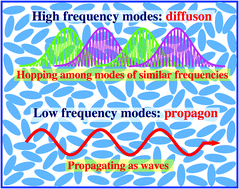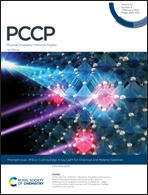Thermal transport in amorphous small organic materials: a mechanistic study†
Abstract
Understanding the thermal transport mechanisms in amorphous organic materials is of great importance to solve hot-spot issues in organic-electronics nanodevices. Here we studied thermal transport in two popular molecular electronic materials, N,N-dicarbazolyl-3,5-benzene (mCP) and N,N′-diphenyl-N,N′-di(3-methylphenyl)-(1,1′-biphenyl)-4,4′diamine (TPD), in the amorphous state by molecular dynamics simulations. We found that due to the softness of organic materials, the low thermal conductivity of both systems can be greatly enhanced under pressure. Notably, in such systems, the convective term of heat flux provides an important contribution to thermal transport as it cross-correlates with the Virial term in the Green–Kubo formula. Mode diffusivity calculations reveal that low-frequency modes can contribute significantly to thermal transport in both mCP and TPD. By increasing the pressure, the sound velocity and relaxation time of such low-frequency modes can be enhanced, and a part of these modes converts from diffusons to propagons. The cooperation of these three effects is responsible for the strong pressure dependence of thermal transport in amorphous organic systems. Molecular pair heat flux calculations demonstrate that heat transfer mainly happens between pairs of molecules with distances below 1.4 nm. This work paves the way for the optimization of thermal transport in amorphous organic materials widely used in opto-electronics, e.g. as OLED and OPV.



 Please wait while we load your content...
Please wait while we load your content...